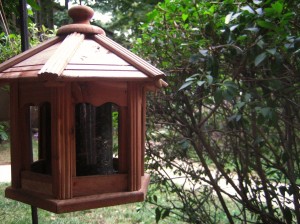
Our cedar bird feeder
Before my grandparents moved into an assisted living facility in the summer of 2008, my grandfather prided himself on the dozens of bird feeders and birdhouses in their backyard. He would spot dozens of local birds visiting the feeders and nesting with their broods, and it always brought him such joy to watch these feathered friends taking up in their backyard.
When David and I moved into our new condo here in Metuchen, we decided to install our own bird feeder next to our small front patio area. It’s positioned near our front window so we can see our fluttering visitors as they arrive and indulge in seeds. While keeping a bird feeder is far from difficult, here are a few pointers that you should keep in mind as you install and enjoy a lovely new feeder:
- While some birds might be brave enough to venture right up to your window, others won’t come near a feeder suctioned onto your window. Plus, if a bird misjudges the distance to the feeder, it could accidentally crash into your window or wall and injure itself. In fact, in residential areas, collisions with windows are the number one bird killer according to Margaret Roach.
- Before you buy, look at several designs to find one that best fits your decor and style. Some like the simple charm of a plastic feeder with tiny perches. Others prefer elaborate house-like designs that look like a miniature hotel. Personally, I liked the woodsy elegance of this cedar house with a protected plastic core. It blends in nicely with the bushes next to it.
- Place the feeder high enough to protect birds from cats and other predators. A shepherd’s hook works nicely as long as it’s tall enough–at least five or six feet tall. If you have a problem with hungry squirrels trying to raid the feeder, liberally grease the shepherd’s hook with vegetable oil or shortening. The next time a squirrel jumps onto the hook, it’ll slide right down and scamper off with sticky paws.
- Common birdseed may be cheap at the grocery store, but its price comes with a downside. For every seed that lands on the ground uneaten, a new weed will almost certainly pop up. The area around your feeder will quickly become covered in a lush carpet of weeds and grasses, not exactly a prime situation for a landscaping aficionado. I use sunflower seeds for my feeder–the larger seeds are less likely to fall to the ground uneaten, and even the ones that do take root quickly die off in the sunless area. Even if the sunflowers sprouted and held out, they’d be a welcome garden addition!
- Look for birds in the early morning and again in the late afternoon. Stand quietly by your viewing window, and avoid any sudden movements that can scare them off.
Bird feeders are so elegant and fun, and I encourage everyone to enjoy nature’s feathery flyers using one (or three) of them! They’ll gladly provide you with a great natural chorus perfect for a breakfast sonata, a lovely treat when enjoyed with coffee and fresh fruit.
Do you have a bird feeder? What kind of seed do you use? Tell me about it with a comment below!




Bird feeders 101 | Long Distance Inc
Maria
Sue